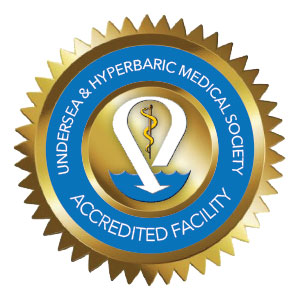
From the 2024 4th Quarter Pressure

Building and Maintaining a Quality Program for Hyperbaric Facility Accreditation
A quality program for a hyperbaric facility must be designed to achieve accreditation and be sustainable over the long term. Maintaining a quality program that aligns with UHMS Hyperbaric Facility Accreditation requires a consistent focus on process improvement, staff engagement, and proactive management practices. Here’s how to sustain a high-performing quality program after accreditation.
1. Embed Continuous Monitoring and Assessment
Once a quality program is in place, routine monitoring and assessment are essential to ensure it remains effective. Key strategies include:
- Regular Audits: Conduct periodic internal audits to verify compliance with policies, safety protocols, and clinical standards. Audits should cover patient care practices, chamber maintenance, and documentation to detect any gaps early.
- Performance Reviews: Key performance indicators (KPIs) should be reviewed routinely. They should reflect clinical outcomes, patient safety, equipment reliability, and patient satisfaction.
- Benchmarking: Compare facility data against industry standards and other accredited facilities to identify areas where your facility may excel or need improvement.
Regular monitoring allows the facility to quickly address any emerging issues and prevent lapses in quality or safety.
2. Conduct Routine Policy and Procedure Updates
Healthcare standards, technology, and best practices in hyperbaric medicine continually evolve, and policies should adapt accordingly. Maintain the quality program by:
- Annual Policy Review: All policies and procedures must be reviewed annually to ensure they remain current. Policies must also be updated in response to new regulations, standards, and emerging clinical evidence in hyperbaric medicine.
- Staff Involvement: Staff should be involved in policy reviews and revisions to ensure that protocols are practical, up-to-date, and have buy-in from those implementing them.
- Documentation: To ensure continuity and compliance, keep thorough records of all policy changes and communicate them effectively to the entire team.
Routine updates help ensure the quality program evolves alongside the codes, standards, and guidelines.
3. Maintain a Strong Focus on Staff Training and Competency
Maintaining high staff competency is vital for long-term quality and safety in a hyperbaric facility. Training should be treated as an ongoing priority:
- Regular Training: Provide periodic refresher training on critical protocols, such as chamber operations, emergency response, and patient management in hyperbaric settings. Schedule regular simulation exercises and mock drills to ensure staff are confident in handling emergencies.
- Continuing Education: Encourage staff to pursue advanced certifications and participate in ongoing education opportunities, especially in areas relevant to hyperbaric medicine and patient safety.
- Performance Evaluations: Conduct regular competency assessments to ensure staff meet required skill levels. Targeted training sessions address skill gaps and align the team with the facility’s quality goals.
A well-trained team reinforces the quality program, as staff are better prepared to deliver consistent, safe, high-quality care.
4. Foster a Culture of Continuous Quality Improvement
A Continuous Quality Improvement culture sustains the quality program by engaging all staff in identifying and implementing improvements. Key steps include:
- Quality Committees: Hold regular meetings with a quality committee that includes representatives from clinical, safety, and administrative roles. This committee can identify improvement opportunities, review data, and monitor the progress of quality initiatives.
- Feedback Mechanisms: Encourage staff and patients to provide feedback on their experiences within the facility. Use this information to identify trends, address concerns, and refine practices.
- Root Cause Analysis and Action Plans: For any adverse events, conduct root cause analyses and establish corrective action plans. Monitor the effectiveness of these actions and make adjustments as needed.
Embedding Continuous Quality Improvement at all facility levels keeps quality improvement central to daily operations. This ensures that small issues are addressed before they escalate and fosters a proactive approach to excellence.
5. Prioritize Comprehensive Documentation and Record-Keeping
Accurate, up-to-date documentation is fundamental to sustaining a quality program and complying with accreditation standards over time. Effective documentation practices include:
- Consistent Record Maintenance: Ensure meticulous record-keeping for all procedures, patient care activities, incident reports, equipment maintenance logs, and staff training records.
- Review and Archiving: Regularly review records to verify accuracy and completeness. Archive older documentation according to compliance standards while ensuring relevant data is readily accessible for quality audits and assessments.
- Electronic Health Records (EHR): Where possible, utilize electronic health records and quality management software to streamline documentation, track performance metrics, and automate reminders for policy reviews or maintenance activities.
Quality documentation practices demonstrate the facility’s commitment to transparency and accountability, both of which are essential for sustaining accreditation.
6. Prepare for Ongoing Accreditation Surveys
Preparing for periodic reaccreditation surveys helps maintain readiness and reinforces a quality culture. Tips for staying prepared include:
- Mock Surveys: Conduct mock surveys that simulate the accreditation process to ensure all standards are consistently met. Identify and address any areas of concern that emerge during these simulations.
- Self-Assessments: Perform regular self-assessments of quality practices. Encourage staff to approach each self-assessment as a learning opportunity rather than a compliance exercise.
- Continuous Readiness Training: Treat accreditation as a year-round process, ensuring that the facility remains survey-ready and that any necessary corrective actions are implemented well before reaccreditation.
Preparing proactively helps the facility maintain high standards and positions it to adapt seamlessly to future changes in accreditation criteria.
7. Engage Leadership and Staff in Quality Goals
Active leadership involvement and staff engagement are crucial for maintaining a high-functioning quality program. Strategies to keep the team invested include:
- Leadership Rounds: Regularly conduct leadership rounds, allowing leaders to interact with staff, observe quality practices, and identify any challenges firsthand.
- Transparent Communication: Keep open lines of communication about the facility’s quality goals, performance metrics, and areas for improvement.
- Recognition and Rewards: Acknowledge staff who contribute significantly to quality improvement. Implement reward programs to celebrate achievements, reinforce desired behaviors, and maintain morale.
A quality program is most effective when all team members understand its purpose and feel valued for their contributions.
Conclusion
Maintaining a quality program in a hyperbaric facility requires constant attention to safety, staff training, policy updates, and improvement initiatives. By embedding Continuous Quality Improvement, documenting meticulously, and keeping the facility survey-ready, a hyperbaric facility can meet UHMS accreditation requirements. More importantly, a sustained focus on quality improves patient outcomes, enhances operational efficiency, and reinforces the facility’s reputation as a leader in hyperbaric medicine.
Congratulations to these Facilities!

July 2024:
Reaccredited:
Garnet Health Medical Center-Catskills
Harris, NY
Garnet Health Medical Center-Orange
Middletown, NY
*McKay-Dee Hospital*
Ogden, UT
Oneida Health
Oneida, NY
Virginia Hospital Center
Arlington, VA
WellSpan Ephrata Community Hospital
Ephrata, PA
WellSpan Good Samaritan Hospital
Lebanon, PA
August 2024
Reaccredited:
*David Grant USAF Medical Center*
Travis AFB, CA
*MedStar Georgetown University Hospital*
Washington D.C.
September 2024
Reaccredited:
Corewell Health Lakeland Hospitals Niles
Niles, MI
Lakeview Hospital
Bountiful, UT
Nuvance Health Vassar Brothers Medical Center
Poughkeepsie, NY
Redlands Community Hospital
Redlands, CA
* With Distinction*




















